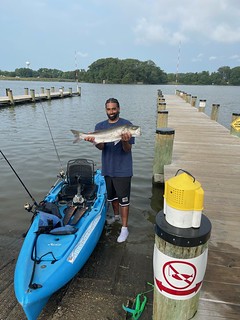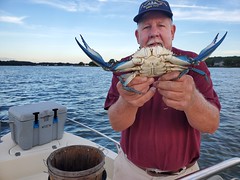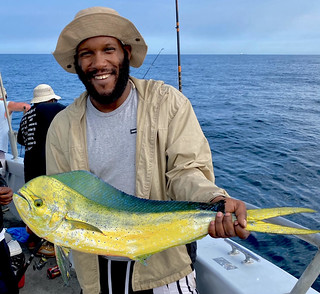Maryland Fishing Report – September 1

Zack Minnick was fishing below Great Falls on the Potomac River and managed to land this whopper of a blue catfish last weekend on his birthday. Photo by Sam Minnick
There are many fishing opportunities in Maryland and many anglers are taking full advantage of the late summer fishing scene.
Although the Labor Day weekend is traditionally the end of the summer vacation season, Marylanders know that great fishing will continue for the months to come.
Be sure to check the Maryland striped bass fishing advisory forecast and continue taking caution to help us protect this iconic species.
Forecast Summary: September 1 – September 7:
Chesapeake Bay conditions will be dominated this week by the impacts of Tropical Depression Ida. These heavy rains in many parts of Maryland as well as the Susquehanna and Potomac watershed will result in high freshwater flows, muddy and cooling waters, and floating debris in the main Bay as well as streams and rivers. Expect higher than normal winds through Thursday. After Wednesday, expect sunny and warm conditions. Bay surface water, river, and stream temperatures have been holding in the low 80s, but expect stream and river temperatures to decrease as a result of the recent heavy rains. Monitoring data is still showing main Bay bottom waters are still slightly cooler than surface waters, but when cooler freshwater flows reach the Bay, surface water temperatures will temporarily decrease and provide anglers opportunities to catch fish in shallower waters.
Adequate oxygen levels are found at all depths from the Susquehanna Flats to Still Pond. Due to low bottom oxygen levels, avoid fishing below the following depths in these locations: Swan Point, 20 feet; Bay Bridge to Bloody Point, 15 feet to 30 feet; Choptank River to Point No Point, 20 feet to 40 feet. On the Potomac River from Colonial Beach to Piney Point, avoid fishing deeper than 15 feet to 35 feet. Conditions can vary daily so be sure to check the depth-to-oxygen level online prior to your next fishing trip to check your specific location.
As a result of the remnants of Ida, expect high flows for most Maryland rivers and streams. There will be above average tidal currents starting Friday a result of the upcoming new moon September 7.
Expect poor water clarity for many of the Maryland portions of the Bay and rivers due to the remnants of Ida. Conowingo Dam is likely to spill water later in the week as a result of the high flows hitting the area on Wednesday. The Potomac River watershed will also experience these rains and the impact will also be seen in streams as well as the main river. In the larger rivers, expect muddy water conditions for several days while smaller streams will clear more quickly. To see the latest water clarity conditions, check Eyes on the Bay Satellite Maps.
For more detailed and up-to-date fishing conditions in your area of the Bay, check the Maryland DNR website for Click Before You Cast. Get regular updates on Maryland’s waters sent to your inbox with our Eyes on the Bay newsletter. Sign up online.

Carvel Walters caught this fine looking striped bass while live lining a spot at the Bay Bridge Piers in his kayak. Photo courtesy of Carvel Walters
Anglers should keep advised of any impacts from Tropical Depression Ida on upper Bay waters. Recently the power generation and water releases at Conowingo Dam have returned to an afternoon-evening schedule, so anglers showing up at dawn to fish the dam pool will find calm conditions once remnants of the storm are clear. The early morning striped bass fishing remains good at the dam pool and the Susquehanna Flats area. Most anglers are casting a mix of topwater lures and paddletails with very good results.
Striped bass fishing continues to be good in the upper Bay. Although the Tolchester Lumps remain a destination for anglers who are live-lining spot, the striped bass are spreading out to other locations in the region. Anglers are finding striped bass holding at Swan Point, the Key Bridge, the Love Point Rocks and the Bay Bridge piers and rock piles.
The most popular way to fish continues to be live lining spot, but jigging can be very successful when striped bass can be found suspended at various locations. Trolling umbrella rigs deep along the shipping channel edges can also be a good option. In all cases, the early morning bite tends to offer the best opportunities as long as a good tide is running. At the Bay Bridge and Key Bridge, drifting soft crab back to the pier bases has proven to be an excellent way to catch striped bass. Fishing with live eels is also another good option. Anglers are urged to review the best catch-and-release practices before fishing for striped Anglers bass on the Department of Natural Resources website. Anglers are also required to use circle hooks when targeting striped bass, to help prevent deep hooking when fishing with bait or live-lining.

Hugh D. Miles caught this nice 30-inch Spanish mackerel while casting to breaking fish. Photo courtesy of Hugh D. Miles
Once again Spanish mackerel tends to dominate the fishing scene in the middle Bay. The Spanish mackerel are spread throughout the region from the Bay Bridge south into the lower Bay. The Spanish mackerel are working on schools of bay anchovies and juvenile menhaden. The schools of bait tend to get pushed along by currents at the edges of the shipping channel and the False Channel, so these areas are often where to find the action.
Trolling small Drone spoons in gold with various color stripes behind planers is a good way to cover water. Casting small metal jigs into breaking fish is a fun light tackle way to fish for the Spanish. Drifting in upwind of the action, casting as far into the fray as possible, allowing the jig to sink a bit and then retrieving as fast as you can reel is a good tactic. Small bluefish and striped bass are often part of the mix so a fast retrieval will help avoid them. Small bluefish tend to nip at anything that moves, so if you must use a swivel on your leader make sure it is black.
Anglers who are getting out on the water early in the morning are enjoying good fishing for striped bass along the Bay and lower tidal river shorelines. Casting topwater lures and paddletails near shoreline structure is the most popular method to fish. The rocks at Poplar Island are an excellent place to cast as is most of Eastern Bay, Thomas Point, and the mouths of the Severn and Choptank rivers.

Trevor Vallandingham was casting in the lower Patuxent River when he got a big surprise with this cutlass fish. Photo by Bob Brown
Anyone who has thoughts of catching some Spanish mackerel ought to make a move in the next week or so. The action could hardly get any better, and looking at the calendar it probably will not. The first big blow and cold front to greet us in September will probably have the Spanish mackerel start heading south.
The Spanish mackerel along with their bluefish sidekicks are harassing schools of bay anchovies along major channel edges throughout the lower Bay. Trolling small Drone spoons and Clark spoons behind planers is a good way to work the channel edges in search of Spanish mackerel. Breaking fish can often be spotted by the presence of diving seagulls, and this is the time to break out light spinning tackle. Carefully come in upwind of the surface action and cast metal jigs or Got Cha jigs as far into the action as possible, allow the lure to sink, and retrieve as quickly as possible. Spanish mackerel are real speed demons and they’ll be able to run down fast retrieved lures. Bluefish are not as fast.
Casting a variety of soft plastic jigs or paddletails along shoreline structure with depths of 6 feet to 12 feet along the shores of the Bay and tidal rivers is a good way to target a mix of striped bass, speckled trout, and legal-sized red drum measuring 18 to 27 inches. The Tangier Sound region, the cuts through Hoopers Island, and the lower Patuxent and Potomac rivers are excellent places to fish.
Those casting lures are also catching a summer visitor to Maryland’s portion of the Chesapeake Bay. The cutlass fish, Trihiurus lepturus, which some are calling ribbonfish, are a fierce-looking fish with a mouth full of large teeth. They can grow to a length of 5 feet and are actually good to eat.
Catch and release fishing for large red drum continues to be good this week in areas near the Target Ship, the Mud Leads and near Point Lookout. Some are being caught by trolling large spoons behind inline weights, others by jigging with large soft plastics when schools can be found or by dropping soft crab baits down to fish that are spotted on a depth finder.
Cobia fishing is showing signs of slowing down as the fish seem to be heading south. There are still some being caught this week by a variety of methods. Chumming is perhaps the most popular way to fish, allowing a fresh menhaden chunk or a live eel to fall into the back of the chum slick. Trolling with rubber hose lures and large spoons is another method as is sight casting with live eels or large soft plastic lures cobia swimming near the surface. The Mud Leads near the Target Ship and Smith Point are two of the more popular places to fish this week.
Spot are getting large enough to find a place on the dinner table, and anglers are enjoying the bounty. The mouth of the Patuxent River up to the Route 4 Bridge is one of the best places to fish for them, Tangier Sound is another excellent location. White perch and small croaker are also part of the mix when bottom fishing. White perch are also being found in the tidal rivers and creeks and some are quite large. Casting beetle spins, spinners, and small jigs near shoreline structure during the quiet morning or evening hours is a fun way to fish with light tackle.
Recreational crabbing continues to move along this week at the same pace we’ve seen for weeks now. The largest crabs — and some of them are real whoppers — are coming from waters from 10 feet to 15 feet in depth. Smaller but legal-sized crabs are being caught in waters as shallow as 4 feet. Trot lines are being baited with chicken necks or razor clams, and collapsible crab traps and hand lines are baited much the same. The crabs are not as far up the tidal rivers and creeks as they were in August

Bluegills are often the first fish that youngsters catch and so it was for this happy little angler, Saoirse Kauffman. Photo by K. Kauffman
We celebrate the beginning of September, and before this month moves too far along we will most likely see some changes occur to the freshwater fishing scene due to cooler weather and rain events. It looks like we are going to receive a lot of rain from what is left of Ida later this week, so it remains to be said how this will affect stream flows.
Basically most trout management streams and rivers run low and clear this time of the year, making for a difficult approach requiring the utmost stealth. Light leaders and lines are usually a must whether, fishing for trout in streams or smallmouth bass in the upper Potomac River. The early morning and late evening hours are optimal times when fish are still active before the heat of the day.
Largemouth bass continue to hold onto a typical summer mode of behavior. Sunrise is occurring later in the morning now and it is becoming much easier to be out on the water at the crack of dawn. This is the best time to fish the shallower areas near grass with topwater poppers, frogs and chatterbaits. Lipless crankbaits, spinnerbaits and jerkbaits can be a good choice along the edges of grass and spatterdock.
As the morning hours wear on, dropping wacky rigged soft plastic worms and stick baits down through grass in deeper areas is a good tactic. Targeting deeper structure such as grass, sunken wood, or rocks with soft craw jigs, grubs or wacky rigged stick worms can entice loafing bass to strike.
Bluegill sunfish are always ready to entertain anglers of any age during the summer months. Casting small flies and rubber-legged poppers with a light weight fly rod offers plenty of fun near grass and lily pads. Casting small lures or fishing with bait under a small bobber with spinning gear is a surefire way to target bluegills also.
Northern snakeheads are on the prowl in most tidal waters within the Chesapeake watershed. The creeks that feed into the tidal Potomac, lower Dorchester County, lower Eastern Shore tidal rivers and creeks, and upper Bay area creeks and rivers are all excellent places to fish for northern snakeheads. This time of the year chatterbaits and frogs tend to get their attention, and it is always a good idea to dead stick a bobber and minnow if you can.
The summer heat has laid a heavy hand on surf fishing fortunes this week. Typically this time of the year waters get about as warm as they’re going to get, and surf species retreat to deeper and cooler water when the sun gets high in the sky. There are a mix of kingfish, spot, and croaker being caught in the morning hours on pieces of bloodworm or Fishbites. Strips of cut spot is a good choice for the small bluefish that are in the surf.
In and around the inlet and Route 50 Bridge area, anglers are casting a variety of jigs near the rocks of the jetties for striped bass and bluefish, with good success. Most of the striped bass are under the 28-inch minimum but offer plenty of fun catch-and-release action. Flounder are being caught at the inlet on traditional baits, the larger flounder are being caught on Gulp lures or by drifting live spot or finger mullet.
Flounder fishing is the top game in the back bay channels this week. The waters are clear, making for good fishing. Hopefully Tropical Depression Ida will not stir things up for the weekend. For those who can get outside of the inlet, the inshore lumps and reef sites are producing some limit catches of good sized flounder this week.
Fishing for black sea bass has been very good at the offshore wreck and reef sites. Flounder are part of the mix and a few party boats have been targeting the small dolphin that are plentiful at the 30 fathom lumps and beyond. Farther offshore the boats working the canyons are catching a mix of yellowfin tuna and dolphin, and catching and releasing white and blue marlin. Those deep-dropping are bringing blueline tilefish back to the docks.
“The life of every river sings its own song, but in most the song is long since marred by the discards of misuse.” — Aldo Leopold
Maryland Fishing Report is written and compiled by Keith Lockwood, Maryland Department of Natural Resources fisheries biologist.
Click Before You Cast is written by Tidewater Ecosystem Assessment Director Tom Parham.
This report is now available on your Amazon Echo device — just ask Alexa to “open Maryland Fishing Report.”




 1-888-373-7888
1-888-373-7888 233733
233733